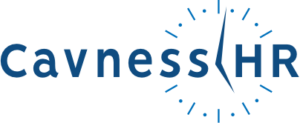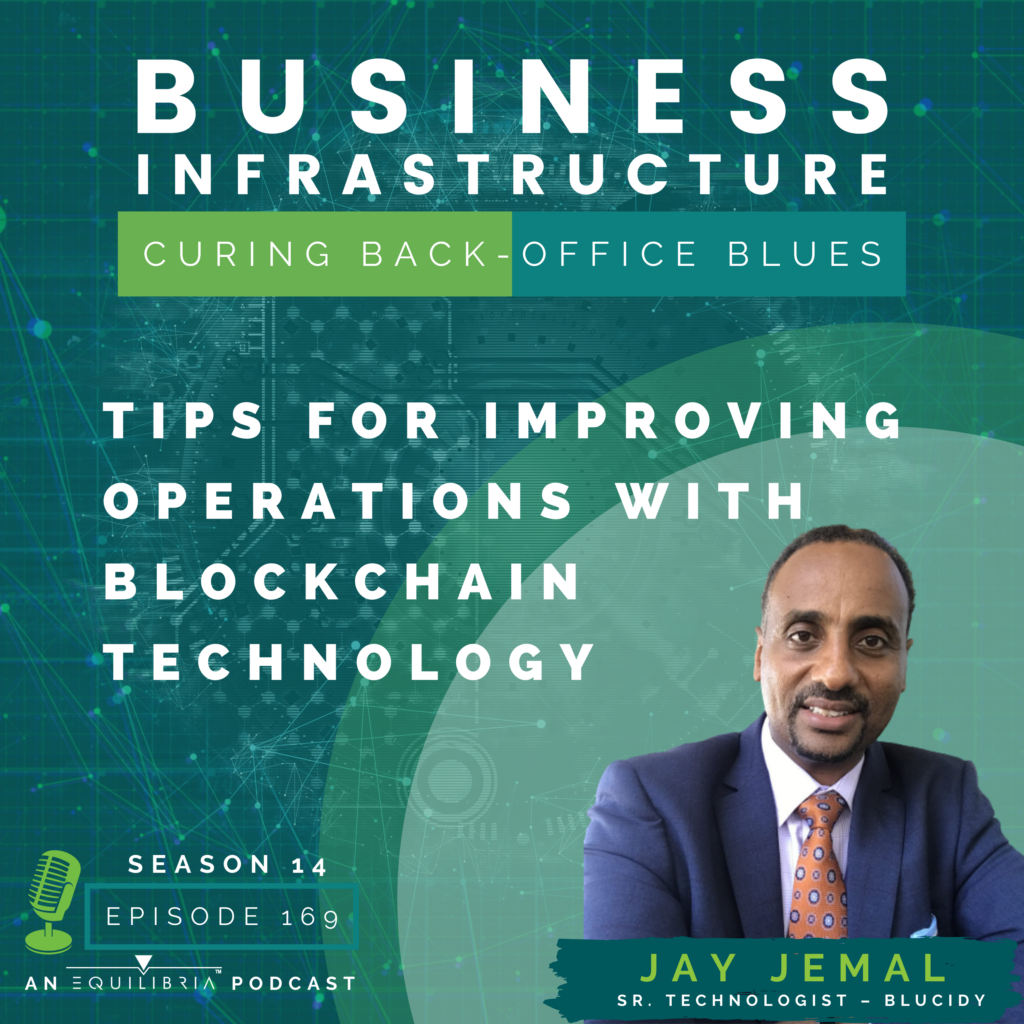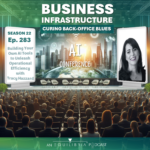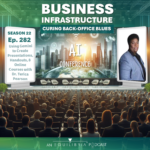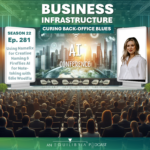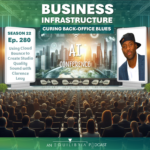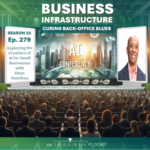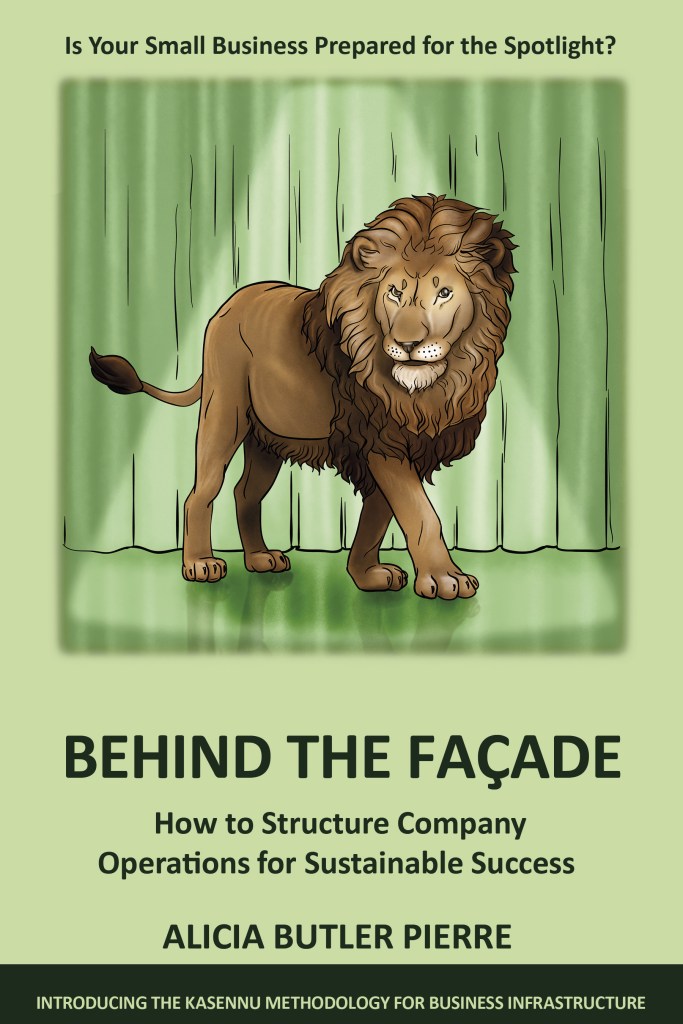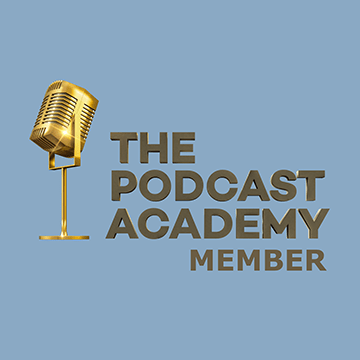Today’s episode is brought to you by Equilibria Inc. Scale your fast-growing business with less pain by hiring the right people, implementing the right processes and leveraging the right technologies. Learn more @eqbsystems.com.
Speaking of leveraging the right technologies, I am so happy to kick off this new season with my good friend and trusted technology advisor, Jay Jemal. He’s here in Atlanta, Georgia, where I also happen to be located. Jay is a Senior Technologist. He has over 20 years of developing software systems for both the private and government sectors. He’s also the Founder and CEO of Blucidy, a blockchain AI startup. Now, if you’re like me, you may have heard of blockchain, but still might be unsure if it’s a technology that can streamline some of your processes. Well, that’s what Jay’s about to educate us on. Jay, we finally made this interview happen. How are you today?
Thank you. Thank you, Alicia, for having me. I know it’s been a while coming. I’m glad to make it here. Thanks for the good things that happened. I believe that. Thanks for having me, I’m glad to be a part of this show.
Thank you so much. And you know, it’s always good when I can have my friends on the show and you know, you know, Jay, this is, this is truly a full circle moment for me. And let me explain to those who are listening right now. Let me explain why I say that, because if you’ll recall a little over three years ago, you were among the first group of people that I shared my idea for this podcast with, and you were so great about giving me feedback. Alicia, make sure your sound is correct. Make sure you have the right microphone. You gave me all of this great feedback from the very beginning and you’ve just been so supportive ever since. So I wanted to make sure that I was officially on record thanking you for your support. So, now that we’ve gotten that out of the way, let’s focus on you, your technology experience, Jay, I was looking over your LinkedIn profile. Oh my gosh, I printed it. And it’s eight pages because you have so much experience.
Your experience is so vast, but it looks like your technology career actually started as a software developer at, am I pronouncing it correctly? Is it No-kia or Noki-a?
Noki-a.
Ok. Nokia. And you know what’s funny? That was actually the first mobile phone I ever had, was a Nokia.
Yeah. So, I could see the progression and over the years you’ve worked for so many different organizations, again, as we mentioned earlier, both in the private, as well as public sectors, a lot of work with the CDC. I know you’ve also been very involved with some things at the United Nations and eventually you started your own company, Blucidy. So I’m hoping we can pick up there. Can you tell us a little bit more about Blucidy and what you do there?
Yeah, definitely. So, Blucidy is a young start-up company based in Atlanta, Georgia. What we do is we try to use technology to solve some of the critical business needs of both enterprise and the public sector. So it does provide a way for transparency, accountability, and reduce the reporting burden while using enterprise, also for any program execute increase impact analysis. And eventually the end point is build a model that can be reasonable for enterprise.
So it’s all about that Transparency and Visibility. Now, so in the intro, we mentioned the fact that Blucidy is a blockchain AI startup. What the heck does that mean, Jay? For those of us who are not in the technology space, it sounds big and scary and something that is just so outside of my lane. So, so can you explain what, what exactly does that mean, a Blockchain AI Company?
Yes, indeed. Indeed. The sun smells a little scary even for technicality like that. So, just to recap my journey from blockchain, it started off, I would say 2017, 16, early on five, six years ago, which is like totally like 20 years in crypto. So it was fast tracking. So we are throwing this idea and so, so in a sense for people who are, I think more familiar with the database, almost similar to a database, a blockchain, but it’s ommittable means it’s a database that’s not going to be erased. So you’re going to have a record all the time, five years, 10 years down the road. So, that’s ommitable means a record that will never change. So, that’s why that’s important, a lot of people asking me, I mean, I can have a database, you know, you know, if you have a database, if somebody had access to your database, they can, you know, manipulate your record, erase your record with __________, with the right privilege, I mean, think of it as burden.
I mean, that’s a, you know, the case in point where he’s admin, right. You can go, erase his tracks, so you’ll never find out what happened. So that’s what I think that got to bring about for a simple term. You cannot change his record, it will be there forever. If you have to change you know that block means it’s continuous, it’s a continuous block of data. So you’re going to have block one, block two, block three. So we cannot take out block two to block four. So that creates transparency. We have visibility into it. So especially for when you do a lot of records stuff, financial stuff, even for pandemic, currently, we do, we want to see what’s going to happen five years down the road, two years down the road from last year. Now we are in the ability, I have a good friend of ______________.
They actually put up COVID data on a blockchain so we can see it. So, this is an unprecedented time. So that is what, a part of what block can oversee. So you’re going to have a record there forever. And now once you have those records. So, you have AI machine learning, modeling, stuff like that. So as somebody told me, a wine is as good as sources. So when you have clean data, data that can be verified, it’s traceable, you can build reputable and also, you know, more close to reality models for AI.
So, okay. Let me make sure I understand. So I’m going to repeat what I think I heard. So, blockchain technology is, it enables you to take these different blocks as you put it, of data, and anytime something needs to be changed, modified, updated. Instead of you being able to go into that original block of data, you have to actually create a new block that reflects whatever changes and updates that you may want. And that’s when you know, having that’s where the chain piece comes in. You have these different blocks of data and they’re connected by this chain. Got it, got it. Okay. So…
That sounds like that’s a core feature. Then you have additional features called consensus algorithm where this data is decentralized. So instead of having this, this study in one place, you can have it in 50 places like 50 states. And so anybody change any place you can see, also the algorithm, the way you actually enter the data to the block is called conscious algorithm. Means I know the majority of the north, they say, okay, we know that this has changed it. And the witnesses, you know, how many witnesses they have. So once they have the witness, you pull those data on the block. So you have data in the block that can be changed. Also the witnesses that attest to that has been changed. Also, everybody has a copy of that data. So, for a task, anything like that, unless you take the majority of the north stuff like that, you still have a secure platform.
So let me, okay. I’m literally sketching out because you know, I’m, I’m a process person, Jay, so I’m sketching out. What I’ve drawn on this sheet of paper that I have here in front of me are literally some different blocks. I’ve drawn some lines to connect those blocks going across the page in a, horizontally. So I love that you started to talk about COVID because this is so relevant, because it’s something we’re still dealing with. So what I put in the first block is, pre-vaccination data. So, data before the vaccines were ever introduced to the general public. So is it that you would have data that has been collected again, pre vaccination, and then instead of being able to go in and just change that data, you would actually have to add a new block of data that says, okay, now this is data that we have within the first three months, just as an example of post vaccination, is that how it works?
Yeah.
Okay.
Not only that, as I said, I’ll send some links to you. So, there are companies like Eco they do in real time. As people vaccinated yesterday, you can see the population of the vaccinated, the region they vaccinated, what type of vaccine they got. So then, in real time, you have a data feed, then you will grow your blockchain data and people are going to see that.
[09:47 – 10:12] Okay. And the reason that’s so important as you said, is that it gives, I guess it shows it truly gives a historical account over time, you know, in terms of patterns and trends and potential changes in data. Whereas, if someone were to overwrite that information, you lose visibility into that historical aspect.
Very good.. Now you’re a blockchain expert.
Oh, look at that. (laughing)
_____________ So, you’re an expert now.
Okay, I get it. I get it.That still doesn’t mean by any means, am a software developer, but I at least understand conceptually what you’re explaining. Now, so in practical terms, Jay, so you mentioned that it’s, it’s really just a database. So how is it, how has it actually accessed? How would let’s say, the CDC for example, is, is there a certain program that they’re accessing that has this blockchain technology feature?
Yeah. So, blockchain technology, the technology, then you have different platforms on blockchain, ___________ then you have Bitcoin. Bitcoin is based on blockchain, but just like a crypto side, then you have Cardona, we have Hashgraph and you have a bunch of flavor of blockchain. For example, you know, though the way we have different batteries or micro sequela, you have Informatica and all that. So you have different protocol of those, then different protocol provider, different performance, different wallet, different features. So if you are an enterprise, you want to implement a blockchain solution. You’re going to come and say what works for me. So you actually use phase and we call, we have call it, discovery phase, where you can map your features to one unit. And also, as you say, in this are in the hospice team, back in the back end, you have all these numbers going and going, how can I have access to you? That, I really don’t care what goes behind the plumbing, right?
I just need the water running into a nice faucet in my kitchen or in Mandarin to take a shower. So to do that, they just call it a DApps. It’s like a web application, like any website we access, you interact with that. I was in India though. I don’t have to deal with that, as well. I don’t have to even know what’s behind is the block and AI. I’m a business person, I want to do my business better, and want to have a value to my clients. I want to do my process improved. So you have a web based application. We call them DApps – Distributed Applications. That’s the name like wave apps. So you can build this UI web based to exceed your user phase. For example, for COVID tracking, you said, you know, there is an application you go in, you can see the trend, how many people are vaccinated, how many people are infected, the hospital use, stuff like that. That is just to aid your access to any website or web application. So they have the front end going and the back end. So as a, you really don’t care. I mean, I could bring an app. I don’t even know it’s a blockchain enabled, it’s AI enabled machine learning enabled, you know, that’s the transferency. I think that should be what a good architect or social actor like you strive to isolate, you know, the back end from the end-user. So you don’t have to burden the end user.
Okay. Because, I’m glad you mentioned that the, you know, making things as simplistic as possible for the end-user, because I’m also wondering for me as an end-user, for example, if I’m working at again, the CDC and there’s this database and I am responsible for entering in certain, certain data, certain health information, is it clear to me as an end-user when I’ve moved from one block of data to the next, or is it pretty much seamless?
Oh, so, in NSA for you, you wouldn’t see a block , but you’ll see torn dash of records , record one record. So for example, when we did a proof of concept for CDC, back in 2018, a proof of concept in a block eighteen and block ten what we did was we was get data from, you know, public health entities, for example, it could be county, it could be state or —————————————————– it has a data of some disease surveillance. It could be antaras, it could be anything else out of identifiable diseases. I think it was Zika virus or something, when you get that data, that data is actually skated. It doesn’t have any API data. So it will be a record, a patient ID, you know, Patient ID , Patient ID 2, record 1, record 2. So you see that those are the block in a blockchain. It could be a block in, generally speaking. So you don’t care about what blocks here or there. I’ve told you about us is simplicity, the base value for any technology solutions. That’s what I strive for, but for you, just see any records. So, at some point, you may see an application builder in a traditional platform, and you can see applications in a blockchain platform. You shouldn’t be able to see any differences. For you, It should be simple. It should be transferred as it is used.
And I would imagine that one of the outputs of, of any blockchain technology is the ability to produce reports based on the data.
Exactly. And I think that the beauty they can report, you know, one year from the start of the ledger, we call Genesis block. When you start your block, you know, all the way, you know, last year, two months down the road, one month down the road. Also, I think you mentioned this earlier, having this quality data will help you to predict analysis. Now you have, by confidence, you can build AI models. For example, now we have known what happens on pandemic last year in terms of capabilities of hospitals, disaster recovery, in terms of, you know, hospital capacities or that in the pandemic trend, the travel, the economy impact the, you know, all that, the job losses. So all that data is available now. We are sitting on a goldmine now that that is called in blockchain, in a few applications, you can build a model for next pandemic will be 10 years, five years, maybe next month, next year, who knows I mean, it’s not a movie anymore, right? We live in through that will allow you to build models in the future.
You know, as I’m listening to you, Jay, I’m also thinking of when government documents, for example, are declassified. And oftentimes you might still see that information has been redacted. And so what I’m wondering is, and I’m thinking now, in terms of application to much smaller companies, it sounds like blockchain technology also prevents that ability for redaction. So once an initial set of data is entered, it’s almost etched in stone. Is that correct?
That’s correct. (Okay) So it didn’t stay in stone but there is some, some ones to that. For example, we have now GDPR for European, for our European listeners. I have a GDPR rule in Eurpe says the right to be forgotten. So it brought a challenge. Okay. Or now, I have a data in a blockchain my healthcare data, if it can be erased, you know, I should have a right to so. By European law, you should. So what they come is like to work around to what the call, own chain of chain. That was a little bit detailed, you know. So you kind of have your data. that’s going to be erased off-chain. I mean, it’s pointed to our record to some data, even this, we do this even for regular filings of x-ray data, you have big financial data because the blockchain is very data sensitive.
So you want to keep on the block, on the chain as small as possible, and you call the big data to off-chain source. So, you can put your off-chain data in something you can risk but stil, the reality that at some point, you have the data, it will be there forever, you know, so they have a pointer to the other, the other data. So, there is some new ones when you have GDPR laws and stuff like that. But as you say, the fact that the area, once you are in the blockchain, you are there.
Okay. I already see why this is so powerful because you truly, you have a true representation of the data without any manipulation.
Source: SemanticScholar.org
Exactly. And that is the key. That’s the golden value of transparency and accountability for blockchain.
Yes. And so now, as small business owners, as leaders, we are empowered that much more to be able to make better decisions, because we know we have sound data, data that hasn’t been retroactively changed or manipulated at some point.
Exactly. I think the source of truth is the keyword here. You know, you want to know where the source of truh for supply chain. I think there’s a lot of initiative from big box and Walmart fit track. The product is also, you know, for supply chain, even in a way products that arrived with touch says what it is combined with IOT devices. Now it should be able to do from your iPhone. If I’m a retail owner, Hey, you know, I have this delivered come in when it’s going to come, you know, when to arrive, so you can have better expected for your clients or restart and so on also for invoicing, you don’t have to worry about, oh, you know, it takes this area tax, especially for your retails crossing, cross country, cross continent. And, any herbal attack, invoicing and it, should we be able to do that, you know, right there also for safety reasons if you are transferring, you know, same pressure, sensitive foods, frozen food, stuff like that, you will be able to track the temperature of your fish.
For example, you know, if you have that fancy fish on the desk or on or something, it should be right temperature. So you should be able to track that on block chain, from the truck, the temperature of say the Freezer, you should be able to adjust it, and you should be able to show that your client, Hey, you know what this has delivered with the right temperature. It was farming the other day before. And you have that idea out for farm to table concept that now you include your consumers, you’re parts of the process. So you can increase your business. You can add value business so you have customer satisfaction with, at the end, have a lot of ROI and I think that’s the endpoint.
And you know, what you’re describing is so important, not just for the larger enterprises that you normally work with, but again, for businesses, I would imagine, or organizations in general of every size, because, because of COVID and the forced digitization of our operations, you know, having that data and, and being able to, to your point, Jay, especially with all of the supply chain challenges that we’ve all been experiencing, it’s so important to be able to tell your customer where they, you know, to be able to track that order, to be able to, to track an invoice, all of these different data points that are being collected. And, and honestly that we, again, especially in smaller companies, we might not always think of these different activities that we’re doing as individual data points, but they in fact are. So if you need to be able to dispute or help resolve a, a billing dispute, for example, being able to go back in time and do your proper research is so critical. And, and again, also in being able to, to track products that may not have been delivered on time to be able to state definitively when it left the warehouse, versus when it got onto a truck versus when it was actually delivered. Yes. Okay. That is powerful, you know, I’m so grateful. I’m laughing too, to hear to myself, Jay, because as long as I’ve known you, I feel like today’s the first time I really understand what you do.
No seriously, like I really, really get it now. I really, I really do, because before, honestly, it just seems so, so vague and so abstract, but just you explaining it as a database and just literally just connecting all of these different databases.
Yeah. Kind of the process improvement excellence and a lot of accountability reporting burden. So what one of the blue city officials we do is, as you see, there’s a lot of issue now with loan disbursement, for example, that our small business supposed to get an investment loan, people apply and they don’t give to the small business. They give to the big business. And I think Obama, I mean, sorry, Biden had an app that get only for small business. So all this, you know, you know, all these inconsistency, bad loan practice, small business like you, me, not getting the right share of, you know, the help we needed because there was no reporting and I worked for government for 15 years, CDC and still amazes me how to work on, on budgeting on finance side of, on grant management, they have more central way of tracking impact, tracking fundus program and so on.
So what at Blucidy we do is that accountability, transparency, also, you can have a burden of reporting. So, lot of small businesses say I’m told to report here, I’m told to report to RS, I’m to to report CRO and stuff like that. And what we’re seeing, what’s the beauty, if you have one place you can report here is you give, you give me X amount of money for this program this is how I used it. This is how I pay tax for it, and you can give a piece of key private key, like a key for somebody for only one day, go get the data. Also, if our risk comes, go get this data. So in that, in that case, it can be a business better than reporting here and there. And so this has been like in a safe, in the safe, does a lot of funding and university, this funding, for example part of my PhD program, cyber security,we get a lot of funding from NSF in my age and the report in a month recording the hospital is unbelievable. And you have so many consistency and they done data. and you know, I have to recite the data again and again. So I think what I see, you know, like blockchain bring is you now, auditability and accountability. Also, you don’t have to do things again and again and again, and in this calls for program management, procurement, contract award, and also in tax or reporting in on that,
This is all phenomenal. And, you know, as I, as I was listening to you just now, Jay, I couldn’t help but think that alone helps shape public perception, especially with the, you know, the, just knowing your company Blucidy and what the focus is on, you know, the public sector and getting the masses of people to trust data that’s being reported. Because as we know, so many people are frankly, and, and, you know, with, with good reason, oftentimes they, they don’t trust the information that they’re receiving. So I think what you all are setting out to do and, and are actively in the process of doing through Blucidy is just so important in that public sector. Now, you’ve, you’ve been great about explaining what blockchain is and, and explaining some of the different possibilities. What I’d like to do is take a deeper dive. If we could look at some particular verticals. And I know this is something that you and I have talked about in the past, in some previous conversations, but before we get into that, let’s first take a quick break to hear a word from our sponsor.
Okay. We’re back and Jay before that quick break, you were really starting to get into the details of blockchain and exploring what some of the different possibilities are and, and how it can actually improve the way organizations operate through greater transparency and visibility of the data. So that’s needed to, to make decisions about how to exactly improve different operations. But as we talk about blockchain, it’s obviously a technology. And as you know, from knowing me all these years, J technology is just one of those three elements that makes up business infrastructure. So for those of you who are listening to the show for the first time business infrastructure is a system for linking your people, your processes, and the tools and technology is like with Jay’s talking about right now to ensure that growth happens in a profitable and sustainable way. Now there’s some blockchain verticals.
There’s so many of them, but I know during a previous conversation, Jay, you were talking to me about the internet of things. And we also talked about retail and the possibilities that blockchain, the possibilities for leveraging blockchain in those two different verticals. Can we first take a look at retail because there might be a several listeners right now who are actually in the retail space in some shape, form or capacity. What’s, what’s the process? How do you even begin to implement blockchain technology? Is there an off the shelf solution that you can purchase or do you have to go and find someone like you and actual developer to build a custom solution?
Yeah, so, so, definitely, I mean, I think one of the AI for blockchain in retail, as you said, and there’s multiple use cases for retail, for example, product tracking, as we said, from farm to table, going away, for example, if you’re a tourist, if you’re a producer or agriculture or something like that, you want to show your client, Hey, you know what it is, that’s come from this farm products for any cost, you know, also that goes to sustaninability, and you know, also on ethical farming. So it has a lot of social impact as well. So you want it to be able to show that value that you’ve been seeing on the farm play, on advertising and in real time, hey, you can try, you know, and other things, you know, whether you sailing, you know, pen and paper also, you know, you might be, you know, you know, economically friendly, you might be green, you might be carbon free.
And so whatever you want to do is bring that up high level and make your consumers participate in that ecosystem. So to do that, there is a lot of way to implement blockchain. So of course you can hire people I’m available, just kidding, but yeah, yeah, yeah, you can, you can implement. and, but what we have seen is because it was a young technology, it was a lot of have a lot of increased stood in the back end, a new compass came in called black and the services, you know, more, nowadays, we used to do a lot harder stuff, but now these are smaller, you know, services, software services, stuff that we can add, you know, you know, email or on the cloud. We don’t care or we’re selling the cloud. We don’t care as long as got access to anywhere.
So similar to that concept, or, you know, a social service, a blockchain combined came in, like one is seen by chain. Also, I know Amazon has a blog and a service. also —————— on the links for info. So these are companies, you can go in and talk to them, or if you are a business analyst who knows blockchain, now you can build a blockchain in the system. So they, they kind of, you know, elevate all that pain of understanding blockchain for you, more of the nice user interface for you to build use cases as a business analyst. So if I’m a business analyst, I don’t know anything about blockchain, but I want this use case to be implemented. For example, we say tracking apple from farm to table, right I want to show this to my consumers. I can go along to the portal, you know, work flows very easy ………. You know, if they have freak count, you can build that. So the back end is in the black, in enabled, you know, the front is for you, for anybody to access for any, anybody, to any one person, anybody to build a blockchain platforms.
So, okay, this, this is a question that just came to mind. What if as a, as a small business owner myself, I’m thinking, wait a minute, I already have a technology, for example, QuickBooks. And I know so many people use QuickBooks. So many small businesses use QuickBooks as their accounting and bookkeeping solution. Is it possible to add on blockchain or, or somehow connect a blockchain technology to the data that’s coming out of QuickBooks Because I’m just thinking again, in terms of how to make this technology accessible to smaller companies who don’t want to, you know, we’re definitely budget conscious, and we don’t necessarily have the capital to create a completely customized solution is a blockchain technology. Is it possible to actually have it connect with some solutions that you already have in place?
Yeah, so, so it’s both yes or no. So it depends what you want to do with drive. So for example, if, if you have any data that exported from cooking books, any of them, you can import your blockchain application, let’s make like an application or now, and it should be able to do whatever you want to do with it. For example, I have a blockchain import from quake, I want to do my invoice. the client will pay in my own time, 15 days delayed, and you want to try and analyze it. Yeah, you can import that data as CSV file or Excel file, and it takes the file and you can import to your blockchain, application. You should be able to do that. Also, you can automatically relate quick and, your Quicken software and send it to some file directory for the black gene to pick it up or the production or whatever it is so you can have. So I don’t think you will have integration direct integration at this point. Maybe there is, I haven’t come across it like for one blockchain, with a cooking, but definitely can take an input of any application data, you know, and import your black and up, and you should be able to do all these cases you want.
Okay. Got it. Got it. Okay. That makes sense. And so, I can already see where this is headed. So you, you go through the trouble of, or not the trouble, but you, you go through the painstaking effort of, of having this of implementing blockchain technology. And the whole purpose again, is to be able to have greater visibility and transparency when it comes to data. But data must also, it still requires protection. And I know that, so that’s where that cybersecurity piece would come in. I would imagine. Yes. Okay. I get it. I get it now, Jay. So, because I know you’re also working on your PhD right now in cyber security at Morgan State University. can we, we’re, we’re starting to run out of time here, but I was wondering if you could quickly kind of take us through that internet of things vertical, and first of all, what exactly does that mean The internet of things and how does blockchain apply to IOT?
Good, thanks. Yeah. So yeah, definitely. I’m working on Morgan on my PhD and my area of research is blockchain security to blockchain and in IOT because IOT security is very rare. It’s in a very infant stage so strong security. So I was, I’m working there under NSF funding in, —————— is a professor in cybersecurity, speaker across the globe. So having to say that, so what works So I see devices, small devices, from, the thing that comes on your phone or your doorbell or your medical devices have spacers, some course A devices some course R devices, but initially it’s a small devices that can have intelligence, some kind of connection to the internet or to some data that that’s the definition of it. So, so yeah, so that was ———————————————-.You know, we see all your shipping them at arrive because ups, IOT, device trucks to their trucks and stuff like that. Data from the trucks to ups Roswell road, I had my friend work on that application. That’s what I know. And that, that is Messiah into your text or something like that. So that connectivity and the intelligence of having that data turn from point A to point B is very powerful, you know, while that in healthcare data. so what my research focus is, in the healthcare space, in the critical IT devices, for example, you have spacers, part of the monitoring, stuff like that, which actually have devastating effect if it is, you know, taken by adversaries, it’s wrongly used, stuff like that. So, there is a concern that that area is not secured. so that’s what my research area is.
If you come through retail area, so we just all show that ups tracking and stuff like that. Also now we have a lot of, retail, on their shelf or inventory systems. I, as anybody else I worked going to college, I worked in Eckerd drugstore when we used to do manual inventory and give to my manager, he have to order this, he have to order that, I wasn’t like interested. Now you can have three devices that can really scan your shellfish and pre-order automatically, so the ability to process improvement and, you know, meeting your customer expectation, which come to ROI. So those IOT devices are there. So if you go into large scale for shipment, we talked about how blockchain I priority. For example, now one of the big iota is another blockchain platform. They specifically work for IOT is, you know, when your shipment arrives from Trans-Atlantic, when it goes from one country to another country, to other borders, you have taxation.
So before they do post billing, now they can real time billing. So you can see past the English channel, being this country in this country, here it is. And also that it will from IOT devices also. and we talked about earlier, you know, the freshness of food. You know, across the sea, across the ocean, you may have different temperatures. First your ability to monitor you are sitting on the line here. You can monitor a ship crossing the Atlantic today in Venezuela or anywhere else or red sea. And Hey, you know, I need to lower the temperature in my food arriving safely with quantity. So, so those are the areas. I mean, it’s a very wide area it’s for its own poor concessions. but I just did a few points. So from healthcare to retail, as well as to big supply chain.
Yes, I tell you, this would go by really fast, Jay. We’re already at time, but before we close, I must ask you for the layman like myself, are there some resources that you can recommend where listeners can go to learn and educate themselves a little bit more about blockchain technology.
Yeah. So what I like to do that is called blockchain101.com. That is a really interesting site, it has been there for a long time. I promote them on LinkedIn and also you can follow me on LinkedIn as well. I usually do a lot of posting on there. So there’s a black number on that is if the tax, it talks from the business point of view, if there is a, you know, learners, you know, dummies for blockchain, it is, is very fascinating. Also they do have a lot of podcasts. They do have sessions at any one session. I think a couple of years back, they start what’s blockchain is the what’s the ledger. Why do I need it to the database in time and how it’s so complex, all those questions. so that area also for a, I think the one you just said, Hey, you know what, I’m brave enough.
I want to build one. You can go to Simbachain.com. that’s seen by, you know, the, the lion king it’s S I M B A. Yeah. So that is, this, our partners. They do blockchain, a service, a great company, small company, they’re out of university, leading, great things in, in military areas space. And, I learned, like the interfaces, you go there, you just define your field. I want to do for supply chain. I want to do for retail, or even for your process improvement, and you can easily build you scale this, and we will have a blockchain platform. so that, that’s very interesting. That’s for anybody to go there, they have a free tier and it should be able to play with it, you know.
Hmm. And you did mention some, some very specific companies. I want to make sure we capture those as well. Can, can you kind of go through those one more time for us, Jay?
Yeah. So we have Blockchain 101 and also we have simbachain.com for black diamond. One is more of a materiality training and stuff like that.
I’m sorry. I thought earlier, there were some, when you were, you know, we were having a discussion about, you know, how can you actually implement this at your company And you, you, you mentioned some very specific companies or maybe consulting firms or something like that, or maybe I misunderstood.
Yeah. So that’s simbachain.com. Yeah. So that gave me a super blockiness service means for anybody, any business analyst to build your blockchain application for retail, like you I’m process improvement company kind of build a blockchain. You can do that. And the 101 blockchain.com is the actual, you know, information training, stuff like that.
Okay. Awesome. Awesome. So, and, you know, real quick, real quick, I know during a previous conversation, we said, if we have the opportunity to at least mentioned NFTs, we would just really quickly J seriously, really quickly, what is an NFT and where is there a place where you recommend, we go to find out a little bit more about them?
Yeah. So, so, NFTs called and they will talk on this means, man, they are, not be exact changes, versus find-able which like Bitcoin Bitcoin is one-to-one right. You have exactly the same thing, you know, find-able like, assess like for a lot of them are like actors or Twitters for like my cell his Twitter for 2.9 million. So this means you have a digital asset that you own that is registered on the blockchain. So you can sell that, you can rent that, you can lead that. So that’s the new trend came out this year. So I’m sure you guys have heard a lot of areas to explore. There are a lot of artists being sailing. A lot of baseball card is how the other data with the booklets or the listening people would try to sell memorable, even Mohammed Ali stuff like that. So if you’re sharing artists,wide play space if you are in the sport already and stuff like that, a very wide area to explore. but definitely a new one, in the upcoming technology, it is reviving the blockchain space. So we should check it out. Maybe we should have another specific podcast for that.
Yes. We would definitely have to do an episode just dedicated to that exclusively. So before we wrap up, Jay, what is the best way for people to connect with you?
So I think I’m more of a, yeah, I’ll say I’m LinkedIn junkie. And so I spend a lot of time there and I find it very, you know, in a professional I had sent by the social people, hit me up on LinkedIn and Twitter as well. So those are the two ways I can connect also, you know, if on the Emmy’s or LinkedIn, I could provide, some other, you know, email other connections.
Sure, sure. Well, I’d like to just quickly, I know we’re, again, we, we really are running out of time here, but I do want to just quickly recap some, some important things that you share with us about blockchain and how it can be a game-changer even for the micro-enterprise. So I just think it’s so powerful. Some of the things that you mentioned starting with what the definition of blockchain actually is. So you described it to us as really just a database, but rather than having a database where data can potentially be altered or updated or changed or written over, that’s not how blockchain works. Once you enter in that initial data set, if you ever want to make a change or add additional information that actually is tracked monitored and logged in a new block of data and having all of these different blocks together is what forms that chain hence the name blockchains.
And that is the most simplest definition that I can think of. But, but you know, we, we talked about the fact that, you know, it, it, the, the benefit of it is again, having that transparency and visibility of the data, you can actually trust the data and having data that you know is trustworthy, having that single source of truth. As you mentioned, Jay is so empowering for anyone who is in a decision-making capacity, whether you own a company, you’re the COO you’re in charge of operations, whatever the case may be, you can only make decisions based on the data that you have. So if you have the more trustworthy, your data is obviously the better informed decision you can make. Blockchain basically eliminates the possibility for redaction of data. I also appreciate the fact that you shared with us, you know, these two verticals retail, as well as the internet of things and how even with retail, just being able to be, to use blockchain technology, to track an order, a product from order to delivery, or as you describe what the restaurant business from farm to table, being able to track all of that entire supply chain from the moment you’re, you know, you have your raw materials to actually delivering the product or service to a customer.
I also could appreciate, I have a much better appreciation, I should say of how cyber security plays in all of this. Because as you know, with data, now that you have data, that’s a single source of the truth. That data still needs to be protected because it can be compromised. So that’s why cyber security is also so important. And then just mentioning that yes, data integration may not necessarily be available right now for blockchain technology, with some of the other applications that you’re using in your day to day operations. But you do have that ability to export data from those applications and import that into a blockchain solution. And that if you want something that’s completely customized, definitely contact someone like yourself, a software developer who can make that happen for you.
If you want more details about Jay, his company, Bludicy, and how your company might benefit from blockchain technology, make sure you connect with Jay again, he mentioned he’s very active on LinkedIn. You can look for him there. What’s your Twitter handle J Jamal. Okay. So at J Jamal. J thank you so much, this was a real treat. I really appreciate you because I know I know how busy you are as studying for it, you know, preparing for your PhD. So I really do appreciate you taking time out to speak with me today.
Thank you, Alicia, you’re now an expert in blockchain!
So watch out, everybody watch out, you know, who knows what’s coming next from me so make sure you, don’t forget to check out businessinfrastructure.tv, because we’re going to have links to all of these resources that Jay has mentioned throughout the interview. You’ll be able to quickly click on links and access that information. You can also click on the link that’s available in this episodes description, wherever you’re listening to the podcast right now, you’ll also find more information on our sponsors. Please make sure you support them because when you do it helps us keep this show free for you. Thank you so much for tuning in and for being a loyal subscriber, remember, stay focused, be encouraged. This entrepreneurial journey is a marathon and not a sprint. And by the way, don’t forget to keep operating as good on the inside as you look on the outside.
Until next time.

